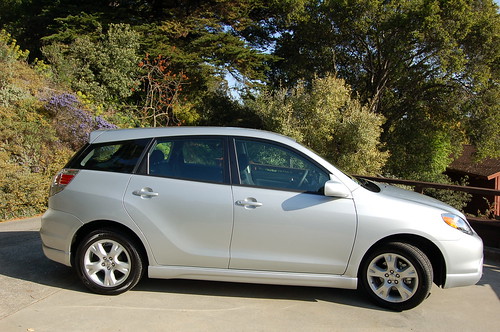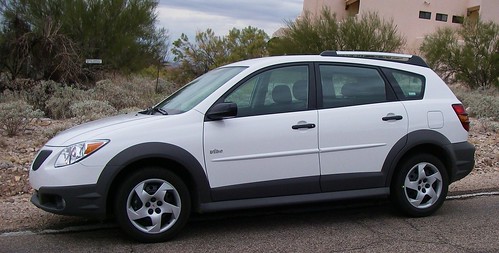
Image: JasonUnbound
In likely the largest single financial meltdown since the Great Depression, I feel inclined to beg of you to run out and buy a new Chevy to bolster the ailing auto industry. But, that’s not really what this feature is about. What got us into this mess likely won’t get us out – that is, buying new cars we don’t need or can’t afford. So, in the spirit of the Union-made conveyance, this installment of Best Economical Used Cars goes to the first-generation Pontiac Vibe / Toyota Matrix.

The GM/Toyota alliance has a rich, yet somewhat little-known history. Since 1984, the NUMMI (New United Motor Manufacturing Inc.) plant in Fremont, California has employed UAW workers. The plant has assembled brand-shared rides like the ’85-’88 Chevy Nova (Toyota Corolla Sprinter), ’90-’02 Toyota Corolla / Geo-Chevy Prizm, the Tacoma, many exported combinations, and the thrifty, wagon-like Vibe/Matrix (including the right-drive version called “Voltz”). These cars are essentially a tall, Corolla wagon/crossover with a Toyota drivetrain and GM bits-and-pieces (60% Toyota, 40% GM). Yep, it’s a strange brew, but a tasty one for sure.
Since their inception in 2003, both models carried their own unique styling and options, yet shared the same DNA under their clothing. Over the model years, some could be bought with All-Wheel Drive, sport packages like the 164 SAE Horsepower XRS (Toyota), and a 6-speed manual transmission. The base 1.8L models offered 126 HP and a 5-speed manual or 4-speed autobox. At their core, the twins shared the commonality, utility, and efficiency of the Corolla – but with a bonus: cargo capacity.
To meet the qualifications of this segment, reliable, quality vehicles have to be easily found, with low mileage, and at a reasonable price. A quick search revealed several units in the sub-100K mile range, for as little as $6,000-$7000.  Pontiac models run a bit cheaper, but it’s just brand identity and nothing more. The Toyota has the same parts, different logo.
On the Inside: The vehicle accomplishes quite a lot in it it’s entirety. The interior trim is basic and plasticky, but who cares? The look and substance exudes durability. Feature content includes a 115V inverter to connect AC items — to charge a cell phone, etc. This vehicle is designed for efficient convenience.
The driver’s seat is tall and nearly identical to the Corolla. Although adjustable, the seating position is rather awkward and uncomfortable. Nevertheless, controls are easy to reach and the instrument cluster exudes an attractive glow with its deeply inset, electroluminescent gauges. One observation: my driving position blocks a clear view of the speedometer by the small steering wheel (duck-n-view). To keep costs down, the Pontiac radio unit and vent outlets are placed in both models.  Small nitpicks, but the driver’s position is rather funky. Overall, the feel is tall-crossover instead of (dare I say) “Wagon”.

The cargo area is where this vehicle excels. The rear seats fold flat (including the front passenger seat) to allow the transport of long items. It’s a true wagon, so expect that sort of utility (and appearance). Tie-down loops and channels, a tough, hard plastic load floor, and minimal wheel-well intrusions make hauling easy. Cleanup of cargo spills are a snap. Who needs a small truck when a good hatchback will do?

Interior Images: stephenHUBBARD
Rear seat passengers may find the legroom a bit cramped if adults are the passengers, but short trips are OK. If kids tag along, then no worries. When the rear seats are in the up and locked position, cargo space finds itself a bit tight. Remember, this is a compact 5-door — which makes it a real fuel miser, but small on proportions. The Toyota is a bit more refined on both interior and exterior appearances, including the optional leather interior. Teamed-up with cargo capacity, fuel economy is the best benefit.

Pontiac VibeÂ
Image: Hendrixson
On the Outside: Both iterations share the same sweeping roofline, wedgy front and rear aspects, and 5-door silhouette. The Toyota has a smoother look to the eye, with full cargo glass instead of the Pontiac’s stylish notch (which creates a bit of a blind spot). GT and XRS models look sporty and play the part with larger alloy wheels, foglamps, side sills, and a rear spoiler. The Pontiac exudes a Fisher Price-esque durability with hard plastic cladding, a roof rack, and sharply angled styling cues.
Under the Hood and ‘The Drive’: Pop the lid, and you’ll find the bulletproof Toyota 1ZZ-FE mill (the 2ZZ-GE is found in high-output models). Choose the 5-speed manual for optimal efficiency. As is usual in North America, most cars you’ll find are automatics. The trick is to keep the speed at or below 70 MPH to avoid transmission kickdown on hills, and consistently high revs at cruise. Fuel economy drops significantly at speeds above the 70-mark.  Keep it steady, and you’ll be rewarded with a variable valve timing response that’s punchy, especially in the mid-range, along with a combined fuel economy in the 30’s. Crisp, small-car handling is the norm from even base trim levels. Body roll is minimal, and the ride is compliant. The automatic shifts firmly and is quick to downshift to the optimal RPM. It’s still a fun car to drive despite what its personality may indicate.
The Data:
Vehicle Tested: 2008 Pontiac Vibe Base
Engine: 1.8L Toyota Powerplant with VVT — rated at 126 HP and 122 lb-ft torque, 4-speed Auto
EPA Class: Small Station Wagon
EPA FE: 25 City / 31 Highway
Averages as Tested: 35.5 MPG at 57 MPH avg, over 455 miles.
Route: Kansas City – Wichita, KS – Kansas City (hit rush hour on the return)
Weather Conditions: 40F – 55F, Wind Speed vs. Heading: NW @ 5 MPH. Course 1 = SSW; Return = NNE
If you liked this post, sign up for out RSS Feed for automatic updates.
Popularity: 6% [?]




{ 5 comments }
This is one vehicle that I have debated on getting at some point. Personal opinion, the Matrix gets the nod except for the price. Sad that two sister vehicles like this can still have such a price difference.
I had no idea that this co-mingling existed till last week when Joe Scarborough mentioned it on his early morning program.
now thats what a utility car should look like and i love this car.
tink i need one.
Just a quick point — while the Vibe is built at NUMMI, the Toyota Matrix is built at TMMC (Toyota Motor Manufacturing Canada), so it wouldn’t exactly qualify as Union-made.
The 03-08 Vibe is also available in a Monotone package, which eschews the raw plastic sides for painted panels.
In the last few years, my family has fallen in love with Vibes. Toyota reliability and mileage from the Corolla engine and transmission, yet Pontiac pricing to purchase them new or used, and money in to our local economy since NUMMI isn’t far away. We’re up to four Vibes in the family, now that I finally got my ’08 earlier this week (which looks nearly identical to the white/grey one pictured in the article).
How reliable is the ’04 engine/drive train………154K ? need it for a daughter going to college.
Comments on this entry are closed.